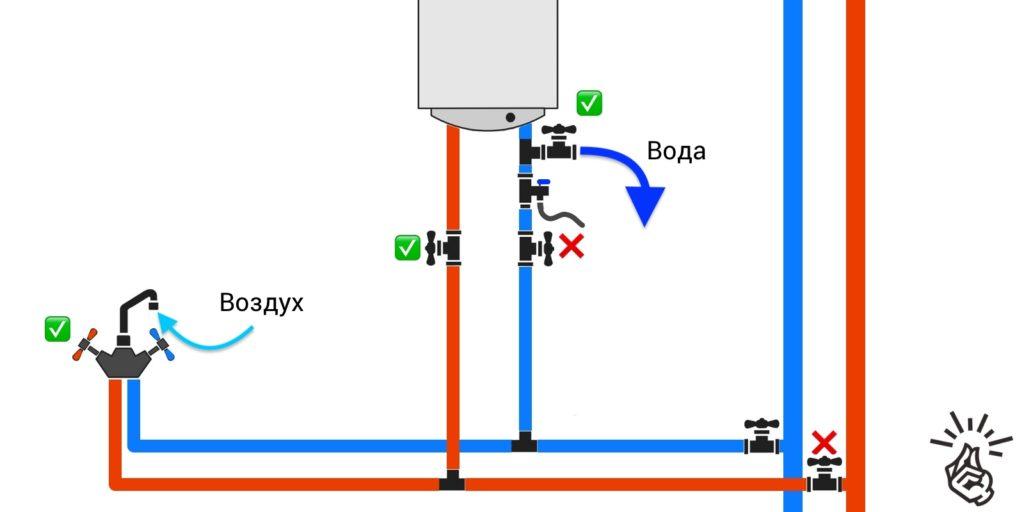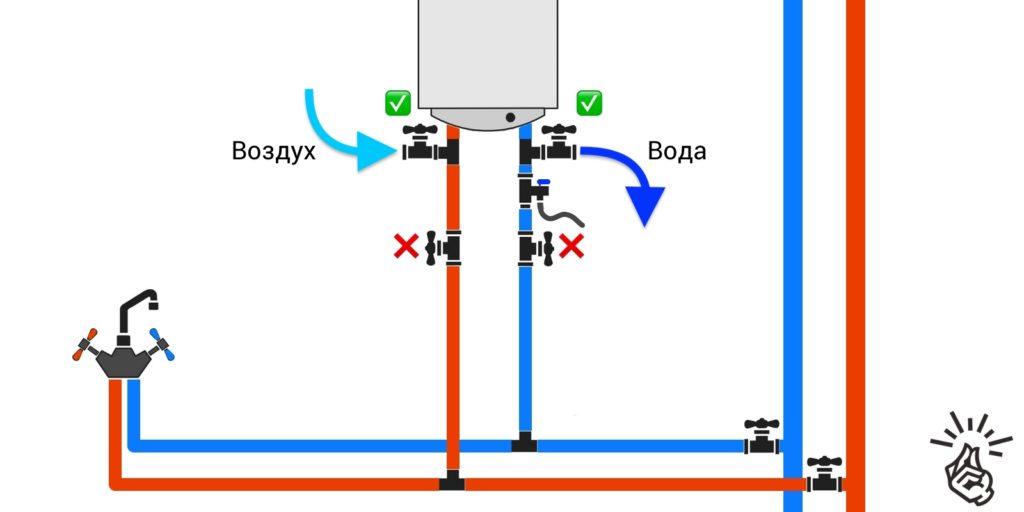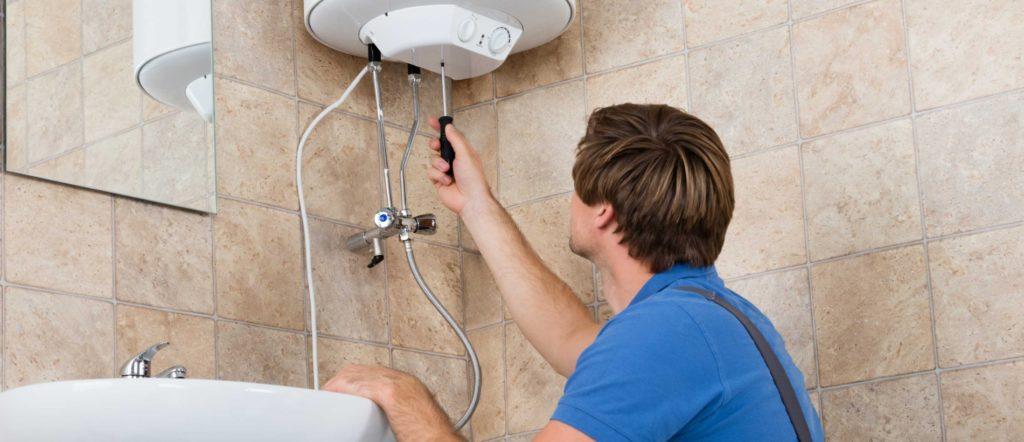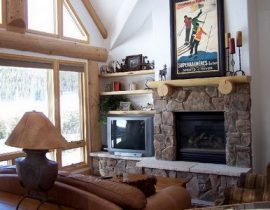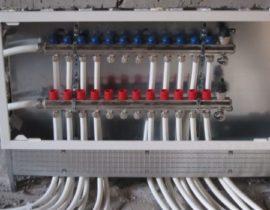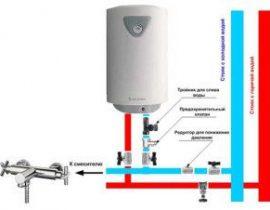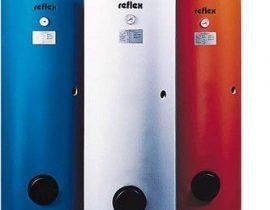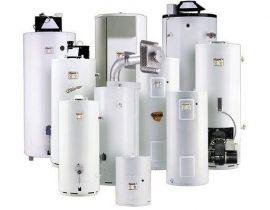The boiler is a storage water heater that allows you to take a hot shower at any time. In operation, the device is primitive, it is enough to connect it to the water supply system and the electrical network.
But there are times when the boiler needs to be descaled or the heating element needs to be replaced. This cannot be done without first draining the water. How to properly and safely drain water from the boiler, as well as speed up and facilitate this process, we will consider further.
Content
Precautionary measures
Before draining the water from the boiler, be sure to observe the following precautions:
- Turn off the power and let the water cool down. Agree, draining boiling water is not only uncomfortable, but also dangerous, as you can get burned. If you plan to drain the water in the morning, turn off the water heater at night.
- Carry out all work only with the plug disconnected from the socket. The boiler must be de-energized before you begin to perform various manipulations with it.
- Do not remove the boiler filled with water, as it is difficult, and the process of draining water can be difficult.
- Shut off the cold water supply using a special faucet, otherwise you will never achieve complete emptying, since principle of operation The boiler allows it to produce hot water while pumping cold water.
- Find capacitywhere the water will drain and prepare it in advance.
Boiler drain options
Modern models of boilers in the technical specifications indicate the need to install a shut-off valve, with which you can quickly and comfortably remove water from the heater at any time. But not everyone does this, bypassing the installation of an intermediate pressure valve, which removes excess pressure from the tank, especially at high temperatures. We will analyze all possible options for draining.
Through a tee and an additional tap
This option is considered the simplest and most convenient. When installing the boiler in the area between the cold water inlet and the source, a shut-off valve is placed.
The drain technology is as follows:
- Turn off the network, cool the water in the boiler.
If you urgently need to drain the boiling water, then you can open the hot water supply on any mixer, turn off the boiler from the network and wait until cold water is filled into it. The method is fast and efficient, but uneconomical, especially if the boiler has a volume of more than 80 liters.
- Turn off the cold water supply to the boiler.
- Open hot water and drain as much as the pressure inside the boiler allows.
- Without shutting off the hot water on the mixer, connect a hose to the shut-off valve and open the valve. Air will enter the boiler through the mixer, maintaining the desired pressure.
The hose is best lowered into the bath or substitute a bucket. After 10-15 minutes, or even less, all the water from the tank will go away.
Advantages:
- Fast and convenient;
- No need to unwind the structure and use special tools;
- You can do it yourself without anyone's help;
- Safely;
- Not laborious.
Flaws:
- It is necessary to strictly follow the instructions and install a shut-off valve at the stage of boiler installation.
Remember that sooner or later, any water heater needs cleaning, which involves draining the water. Therefore, do not save on installation and install an additional tap on the tee so as not to mess around with basins and buckets, literally collecting water drop by drop.
Through the double tee
Some craftsmen, in order to save their own strength and time to drain water, make two tees. One is located at the entrance, the other at the exit. What gives such a design? Everything is very simple! You do not need to open the mixer valve to equalize the pressure. Just turn off the water supply, open these two shut-off valves and rejoice in the truest sense of the word.
Advantages:
- Acceleration of the drain process;
- Maximum comfort;
- Ease of use.
Flaws:
- Costs for cranes during installation.
With such a device, you can drain water from the boiler at least every day, without making any physical effort.
Through the pressure valve
All models of boilers are provided with a pressure valve, which is installed above the water intake valve. Its main purpose is to remove steam and reduce pressure in the tank when the maximum heating temperatures are set. When the pressure rises, the device automatically releases steam and some water, which helps to prevent an explosion.
The method of draining the water through the pressure valve is somewhat cumbersome, but can also be used. Necessary:
- Shut off the cold water supply to the tank.
- Open hot water on the faucet and drain as much as the system allows (usually no more than a glass).
- Find the flag on the pressure valve and, substituting a container under the hole, drain a little water.
Advantages:
- The valve is on any boiler.
Flaws:
- Slow pressure;
- The duration of draining an 80 liter boiler is about 3 hours;
- It is necessary to substitute a container under the valve opening and hold it in your hands so that the liquid does not splash onto the walls;
- When pressure fluctuates, it may be necessary to connect the compressor through the hot water connection;
- Long, slow and laborious, but the method has a place to be, since it does not involve a complete analysis of the boiler design.
In order not to hold water containers in your hands, you can insert a thin hose into the valve hole, lowering it into a bath or toilet. The hose from the drip system is ideal for these purposes.
The fastest way
If a sudden breakdown occurs, and there is no time to wait, then an emergency option is used to drain the water from the boiler by screwing the hoses to the water inlet and outlet.
For this:
- The cold water supply to the boiler is shut off.
- Using a wrench, unscrew the hot and cold water hoses from the nozzles.
- Water is quickly removed from the boiler through two openings.
This method is convenient only if the water heater is located directly above the bath and the outgoing water will not be sprayed all over the room.
Advantages:
- Fast and convenient
- Suitable for all boiler models
Flaws:
- It is necessary to unscrew the hoses correctly, and also correctly return them to their place
The drain process must be controlled as much as possible, otherwise there is a risk of being completely in the water.
Removal of residual water
No matter how long and carefully you drain the water, a small part of it will remain in the boiler.
To completely drain the tank, you must:
- Drain water using any of the above methods.
- Carefully remove the protective cover on the bottom of the tank, which is usually attached with screws.

- While holding the base of the cover, you should carefully disconnect the wires that are there in order to completely remove this element from the main part.
- Find the flange that serves as a support for the inner ten, and then carefully loosen the nuts on it. Water will leak, keep this in mind, so do everything slowly, gradually increasing momentum.
- When unscrewing the nuts, hold the flange with your hand. After removing the last nut, carefully pull the ten out.
You may be surprised at what condition your heater is in and how much sediment has formed in the boiler. Sometimes it is impossible to get ten, as it is overgrown with scale, increasing in size.
General Tips and Tricks
If the installation of the water heating system was not carried out by you, and even the most basic tools are not at hand, then it is better to entrust the process of draining the water to professionals. This will save your nerves, save time and protect you from unnecessary breakdowns.
Otherwise, experts advise:
- Check several times if the boiler is disconnected from the mains. If it is connected directly to the meter, then de-energize it in another way.
- Do not skimp on the installation of shut-off valves that will be directly connected to the sewer. A one-time waste in the future will save a lot of time and effort.
- Do not drain the water radically by screwing on the water hose unless your boiler is installed over a bathtub. There are risks that water under pressure will flood the floor, and you will not have time to change the containers.
- Do not be lazy to clean the ten, if you still had to drain the water. He will thank you, but in practice you will notice that the water heats up faster, and there is no unpleasant smell of a swamp in it.
Properly performed draining of water from the boiler will save you nerves, and the floor will not flood. Better slower, but better. Never pour out boiling water. Be sure to dilute the water with cold water by disconnecting the boiler from the power supply and opening the hot water tap. If this procedure seems difficult for you, then seek help from specialists.
Video advice on how to properly drain the water from the boiler


